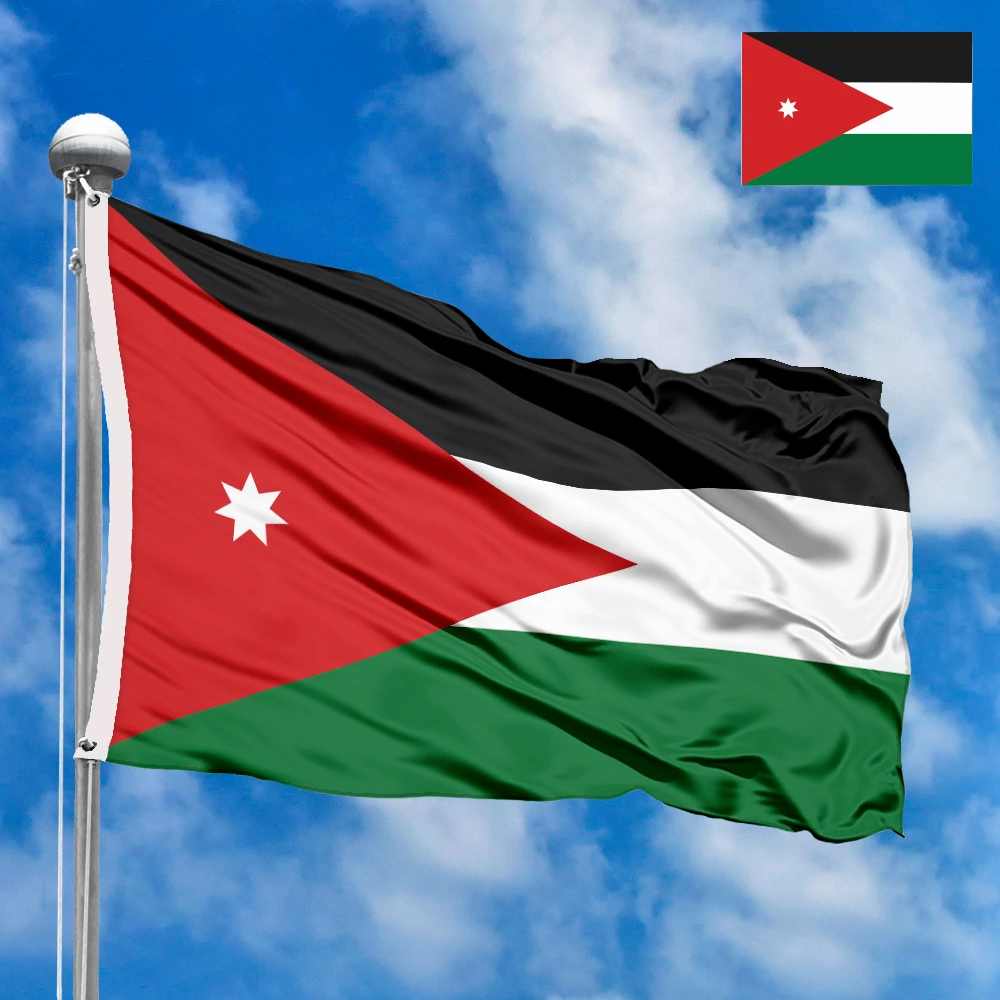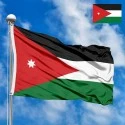The national flag of Jordan is a deeply significant symbol, representing the nation's rich history, its connection to the Great Arab Revolt, and its enduring aspirations for unity, freedom, and independence. It's a powerful visual narrative that tells the story of the Hashemite Kingdom of Jordan and its place within the broader Arab world. Adopted in 1928, this flag embodies both historical lineage and modern national identity.
Design and Dimensions
The flag of Jordan features three equal horizontal stripes of black, white, and green, from top to bottom respectively. Overlapping these stripes at the hoist (left) side is a red isosceles triangle. This triangle extends one-third of the flag's length.
Within the red triangle, a white seven-pointed star is centrally placed. This star is a crucial element, laden with specific symbolism.
The official and most commonly used proportions for the Jordanian flag are 1:2 (height to width), giving it a distinct rectangular shape that is broader than it is tall.
Symbolism of the Colors and Elements
Every color and element on the Jordanian flag carries profound symbolic meaning, connecting the nation to its historical roots, its Islamic heritage, and its pan-Arab ideals:
-
Black Stripe: The top black stripe represents the Abbasid Caliphate (750-1258 AD), a powerful Islamic empire that stretched across vast territories, with Baghdad as its capital. Black historically symbolized the banner of the Prophet Muhammad and later the Abbasids, representing a period of significant Islamic and Arab achievement. It also signifies oppression and determination in the face of adversity, recognizing the struggles endured by the Arab people.
-
White Stripe: The middle white stripe symbolizes the Umayyad Caliphate (661-750 AD), another influential Islamic dynasty that ruled from Damascus. White was their emblematic color, signifying purity, peace, and honesty. It also represents the noble ideals and generosity of the Arab people, and their aspirations for a just and peaceful society.
-
Green Stripe: The bottom green stripe represents the Fatimid Caliphate (909-1171 AD), an Islamic caliphate that originated in North Africa and extended its rule across much of the Arab world. Green is also the traditional color of Islam and the banner of the Prophet Muhammad's family (Ahl al-Bayt). In the context of the flag, it signifies hope, prosperity, and fertility of the land, as well as the blessings of Islam.
-
Red Triangle: The red isosceles triangle at the hoist represents the Hashemite Dynasty, the ruling family of Jordan, and their role in leading the Great Arab Revolt (1916-1918) against Ottoman rule. Red symbolizes courage, valor, and sacrifice, particularly the blood shed by Arab martyrs in the pursuit of independence and self-determination. It also links Jordan directly to the historical banner of the Sharif of Mecca, a key figure in the Revolt.
-
Seven-Pointed Star: The white seven-pointed star within the red triangle is a multi-layered symbol:
-
Seven Verses of Al-Fatiha: It primarily represents the seven verses of the Al-Fatiha (the opening chapter of the Quran), symbolizing the fundamental principles of Islam and emphasizing the nation's Islamic identity.
-
Unity of Arab Peoples: It also signifies the unity of the Arab peoples, representing a hope for a unified Arab nation.
-
Seven Hills of Amman: Some interpretations link the seven points to the seven hills on which Amman, the capital of Jordan, was originally built, though this is a less common interpretation.
-
Trust in God: The star's presence further emphasizes trust in God and divine guidance for the nation.
History of Creation and Adoption
The design of the Jordanian flag is directly rooted in the Flag of the Arab Revolt, which was raised by Hussein bin Ali, the Sharif of Mecca and leader of the Great Arab Revolt, in 1916. This historic banner became a powerful symbol of Arab nationalism and the quest for independence from Ottoman rule.
-
The Great Arab Revolt Flag (1916): The original flag of the Arab Revolt featured the same black, white, and green horizontal stripes, with a red triangle at the hoist. This design was conceived to represent the historical caliphates (Abbasid, Umayyad, Fatimid) and the Hashemite leadership of the revolt.
-
Establishment of the Emirate of Transjordan (1921): After the collapse of the Ottoman Empire and the subsequent British Mandate, Abdullah I, son of Hussein bin Ali, established the Emirate of Transjordan in 1921. The flag adopted for the Emirate was essentially the Flag of the Arab Revolt, with the addition of a seven-pointed white star within the red triangle. This addition was significant as it distinguished Transjordan from other Arab territories using similar pan-Arab flags and specifically referenced the core Islamic tenets and the unity of the Arab nation.
-
Independence and Kingdom of Jordan (1946): When Transjordan gained full independence from Britain in 1946 and became the Hashemite Kingdom of Jordan, the flag with the seven-pointed star was formally retained as the national flag.
-
Official Adoption (1928): While the flag came into use with the Emirate's establishment in 1921, its legal status and detailed specifications were formally codified with the Constitution of the Emirate of Transjordan in 1928, solidifying its design and symbolism. Since then, the flag has remained unchanged, representing a continuous link to its revolutionary past and the Hashemite lineage.
Significance for the Inhabitants
For the people of Jordan, the flag is much more than a piece of cloth; it's a profound emblem of their national identity, pride, and sovereignty. It serves as a constant reminder of the Great Arab Revolt and the sacrifices made for their independence. The flag reinforces their Arab and Islamic heritage, with the colors representing historical caliphates and the star symbolizing core religious and pan-Arab principles.
It embodies the legitimacy of the Hashemite monarchy through the red triangle, connecting the current state to a lineage of leadership that fought for Arab self-determination. The flag evokes a sense of unity among Jordanians, reminding them of their shared history and common aspirations for a peaceful and prosperous future. It is flown with immense respect and pride across the kingdom, from government buildings to private homes, especially during national holidays and events.
Interesting Facts
-
Pan-Arab Colors Origin: The basic black, white, green, and red scheme is known as the "Pan-Arab Colors" and originated from the flag of the Great Arab Revolt, making it a foundational design for many modern Arab national flags.
-
The Only Seven-Pointed Star: Jordan's flag is unique among Arab nations in featuring a seven-pointed star. While other Arab flags might feature stars (like Egypt or Syria in past iterations), they usually have five or six points, or represent different symbols.
-
No Changes Since Adoption: Unlike some of its regional neighbors (like Iraq), the Jordanian flag has remained unchanged in its design since its official adoption in 1928, highlighting a sense of stability and continuity in its national symbols.
-
Connection to Mecca: The red triangle directly links the flag to the Sharif of Mecca, the Hashemite leader of the Great Arab Revolt, emphasizing the religious and historical legitimacy of the ruling dynasty.
-
"Flag of Unity": Due to its explicit symbolism of the "unity of Arab peoples" through the seven-pointed star, the Jordanian flag is sometimes informally referred to as a "flag of unity" within the Arab world.
-
Constitutional Basis: The design and symbolism of the Jordanian flag are explicitly defined in the country's constitution, underscoring its foundational importance to the state.
-
Predecessor of Many: The design of the Arab Revolt flag, upon which Jordan's flag is based, served as an inspiration for the flags of other newly independent Arab states in the 20th century, cementing its place in regional vexillological history.
-
Symbol of Stability: In a region often marked by political upheaval, the enduring presence and unchanged design of the Jordanian flag also serve as a quiet symbol of the kingdom's relative stability.
In the demonstration images, full-size flags are shown with proportions of 2:3, and hand-held flags with proportions of 1:2.






 Waving flag
Waving flag
 Sizes:
Sizes:
 Round flag
Round flag
 Sizes:
Sizes:
 Rectangular flag 2:3
Rectangular flag 2:3
 Sizes:
Sizes: